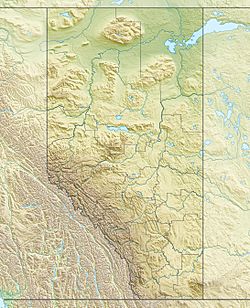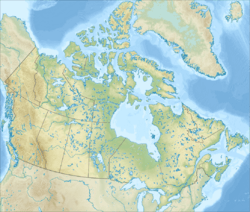Grouard facts for kids
Quick facts for kids
Grouard
Grouard Mission
|
|
|---|---|
| Country | Canada |
| Province | Alberta |
| Region | Northern Alberta |
| Census division | 17 |
| Municipal district | Big Lakes County |
| Government | |
| • Type | Unincorporated |
| Area
(2021)
|
|
| • Land | 4.52 km2 (1.75 sq mi) |
| Population
(2021)
|
|
| • Total | 166 |
| • Density | 36.7/km2 (95/sq mi) |
| Time zone | UTC−07:00 (MST) |
| • Summer (DST) | UTC−06:00 (MDT) |
| Area code(s) | 780, 587, 825 |
Grouard, also known as Grouard Mission, is a small community called a hamlet in northern Alberta, Canada. It is part of Big Lakes County. For a while, between 1909 and 1944, Grouard was its own official town.
Grouard is about 13 kilometers (8 miles) north of Alberta Highway 2. It is also about 171 kilometers (106 miles) northeast of Grande Prairie. This hamlet is where the main office for the Kapawe'no First Nations is located.
Contents
Discovering Grouard's Location
Grouard is found near the western edge of Lesser Slave Lake. This lake is one of three large lakes in Big Lakes County. Its location by the lake has always been important for travel and trade.
What's in a Name? The Story of Grouard
The original name for this area, in the Cree language, was Stony Point.
The community was first called Lesser Slave Lake. Its name changed to Grouard in 1900 when the town was built. It was named after a Catholic Bishop named Émile Grouard. He was a missionary in northern Canada for 69 years. Bishop Grouard moved his main office to Grouard in 1920 and passed away there in 1931. People also used to call the place Grouard Mission.
A Glimpse into Grouard's Past
Grouard has a very interesting history, especially for Indigenous peoples. A very important agreement, Treaty 8, was signed here in 1899.
The hamlet is located near where the first non-Indigenous settlement was. The North West Company set up a trading post there in 1802. Later, in 1871, the Roman Catholic Church started a mission called St. Bernard or Grouard Mission. Grouard became a busy center for trade and transportation in northern Alberta. Many Cree and Métis people lived in the Lesser Slave Lake area.
The site, known as Stony Point in Cree, was chosen for the signing of Treaty 8. This treaty was an agreement between representatives of Queen Victoria and several First Nations. These included the Cree, Beaver, and Chipewyan nations. The Crown wanted to open the land for settlement, trade, and other activities.
On September 27, 1909, Grouard officially became a village. It then became a town in December 1912.
From 1910 to 1916, Grouard was a key stop on the way to the Peace River district. In 1913, over 1,000 people lived there. However, in 1916, the Edmonton, Dunvegan and British Columbia Railway (EDBCR) built its tracks 12 miles (19 km) south of Grouard. The railway chose the southern shore of Lesser Slave Lake instead. Because of this, many people and businesses left Grouard. They moved to High Prairie, a community that was on the new railway line.
Grouard changed back from a town to a village on June 7, 1940. Then, on January 15, 1944, it stopped being a village. It became part of a larger administrative area.
Who Lives in Grouard?
In 2021, a count of the population showed that 166 people lived in Grouard. These people lived in 79 homes. The area of Grouard is about 4.52 square kilometers (1.75 sq mi). This means there were about 36.7 people living in each square kilometer.
Learning in Grouard
Grouard has schools for younger students. Northland School Division No. 61 offers classes from kindergarten to grade 9. After grade 9, students travel by bus to High Prairie for high school. Students in Grouard can also choose to attend school in High Prairie from kindergarten all the way to grade 12.
Northern Lakes College (NLC)
Grouard is also home to administrative offices for Northern Lakes College (NLC). This is a public college with over 25 campuses across northern Alberta. NLC recognizes that its campuses are on Treaty 8 territory. This land is also the traditional home of First Nations and Métis peoples.
The college was once called the Alberta Vocational College (AVC). It was renamed Northern Lakes College on August 25, 1999.
The History of NLC
In the early 1970s, Grouard became the site of a Vocational Centre. This center helped First Nations students get adult education and basic training. The goal was to prepare them to become instructors in the area.
In 1986, there were plans to move some programs and student housing from Grouard to High Prairie. Many people in Grouard protested these changes. After meetings with community leaders and government officials, the decision was changed. It was agreed that college programs would not be moved without talking to the community first.
In 1988, the Alberta Vocational Centre in Grouard joined with other centers. They formed the Alberta Vocational College. Since September 1, 1997, a public board has managed the college.
Northern Lakes College is also part of the Kapawe'no First Nation School. This school is located within the Kapawe'no First Nation territory. In 2019, the Kapawe'no First Nation School received approval from Alberta's Department of Education. The school now offers education from kindergarten through grade twelve.
The Native Cultural Arts Museum is part of Northern Lakes College. It is located in the Moosehorn Lodge at the Grouard campus. The museum has a collection that celebrates different Indigenous cultures. It especially focuses on Métis peoples and the Woodland Cree of northern Alberta.
A Place of Historical Importance
The Grouard Indian Residential School, also known as St. Bernard’s Residential School, was located in Grouard. This school is listed on a special online memorial site. This site is kept by the National Center for Truth and Reconciliation (NCTRC) and UNESCO. The Roman Catholic Church ran this residential school from 1894 until 1957.
This site is recognized by Parks Canada as one of Canada's Historic Places. This includes the St. Bernard mission's church and cemetery, also known as Grouard Mission Church. It is a place of historical importance and remembrance.
Managing Forests in the Lesser Slave Lake Region
The Kapawe'no First Nation, whose main office is in Grouard, helps manage the Lesser Slave Lake Regional Forest Management Plan. They are one of many Treaty 8 First Nations and Métis settlements who share their knowledge. Their involvement helps make sure that forest management respects the rights of First Nations and Métis Settlements. These rights include hunting, fishing, trapping, and using the land for traditional purposes.
Famous People from Grouard
- Pearl Calahasen, a Canadian politician. She was a Member of the Legislative Assembly (MLA) and a cabinet minister from 1989 to 2015.



